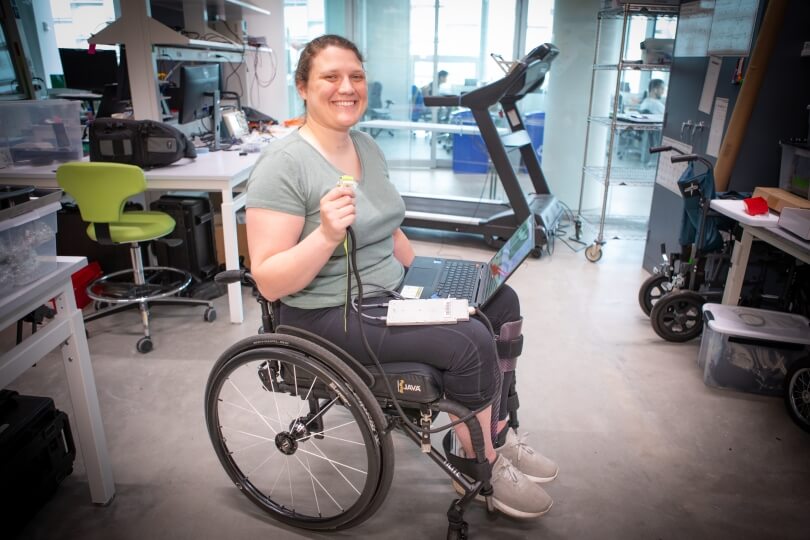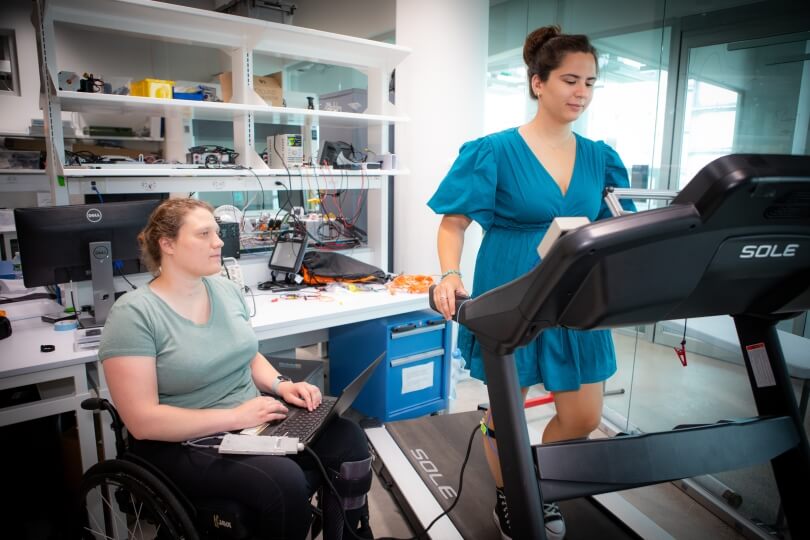Elizabeth Suitor, Ph.D. candidate in electrical engineering and SEAS Office of Diversity, Inclusion and Belonging Fellow. (Eliza Grinnell/SEAS)
The challenges began the moment Elizabeth Suitor attended her first lecture at Harvard. There were no desks for wheelchair users, and the wheelchair-accessible spot was blocked by audiovisual equipment. Suitor, an electrical engineering Ph.D. candidate at the Harvard John A. Paulson School of Engineering and Applied Sciences (SEAS), encountered more problems when she tried to enter a microfabrication cleanroom for the first time.
Both situations were quickly addressed. More wheelchair-accessible desks and suitable space were added to lecture halls, and the cleanroom was reconfigured to add a wheelchair-accessible safety shower, wheelchair cleaning apparatus and clearer evacuation instructions for wheelchair users.
Suitor’s experiences, along with a desire to make information and resources more accessible for her community, led her to join the SEAS Office of Diversity, Inclusion, and Belonging (DIB) Fellows program. The Fellows are a group of eight undergraduate and graduate students who design programming, training, recruitment and outreach for groups that are historically underrepresented in science, technology, engineering and mathematics (STEM).
“One of my hopes as a DIB Fellow is to not just attract more disabled students to Harvard and higher education in general, but to keep them here,” Suitor said. “It’s not an easy thing to do for disabled people. There’s not a ton of built-in support in higher education, so making sure it’s clear where to find that support, and also making sure there’s more support, is definitely one of my priorities.”
While the Science and Engineering Complex (SEC) where she works is code compliant for accessibility, with multiple classrooms and conference rooms equipped with assistive learning systems, and desks and tabletops in common spaces throughout the building varying in height for wheelchair users, there is room for improvement, said Suitor. With her input, several additional improvements have already been made, including moving accessible parking spaces closer to the building, and adding high-contrast tape to stairs and ramps around the building.
“With the SEC being new and generally open, its base structure is quite wheelchair accessible,” she said. “Additionally, my lab has done an incredible job organizing our lab space and equipment in a way that is wheelchair accessible.”
Suitor, with the SEAS Office of Facilities, helped call attention to and refine specific accessibility elements already included in the design of the building, such as the amount of force needed to open a door and the arm reach necessary to open a refrigerator or freezer. As a DIB Fellow, she is already planning new programs for the 2023-24 school year. One of her biggest goals is to bring in disabled people already working in STEM, as a way to bring visibility to the community within those industries.
“There's definitely a lack of visibility in not just STEM, but society in general, for disabled people,” Suitor said. “Generally, I find people are super willing to help, but also probably haven’t thought about it before.”
Elizabeth Suitor, left, is developing ultrasound-based wearable sensors which can measure muscle velocity, here demonstrated by Sofia Cerasi, a colleague in the Harvard Biodesign Lab at SEAS. (Eliza Grinnell/SEAS)
Suitor’s Ph.D. research could eventually benefit members of the disabled community. She’s part of the Harvard Biodesign Lab led by Conor Walsh, Paul A. Maeder Professor of Engineering and Applied Sciences. She’s developing ultrasound-based wearable sensors which can measure muscle velocity. By tracking patterns in how quickly muscles move when they flex, Suitor hopes to develop a noninvasive method of detecting or predicting musculoskeletal injuries.
“Previous research has primarily focused on peak muscle velocity, but we are more interested in using muscle velocity patterns during exercise to better understand and predict injury or disability,” she said. “It's a new project in the lab, so the first application is probably going to be non-disabled people. I definitely wanted to help the disabled community as much as I can, so it’s motivating to be able to do that. The flip side is that I’m working on stuff that will probably help people in 5-10 years, and the existing need is so great.”
Suitor arrived at SEAS with a bachelor’s degree in biomedical engineering from Wentworth Institute of Technology, followed by six years of industry experience. Much of that time was spent at Altaeros, a telecommunications and infrastructure company based out of Somerville, where she worked as an electrical engineer. Wanting to pivot back towards biosensors and the biomedical engineering space, Suitor applied to join Walsh’s lab.
“I was impressed with her motivation, technical expertise and practical knowledge acquired from working at a start-up,” Walsh said. “Elizabeth is a very collaborative lab member and both looks to others for advice but also shows her own technical and personal perspective with others across projects in the lab.”
The opportunity for interdisciplinary collaboration drew Suitor to Harvard, as did the potential for more interesting job opportunities should she return to industry after getting her Ph.D. Walsh’s lab had previously researched using ultrasound imaging systems to monitor muscle dynamics, but Suitor’s innovations could add portability and customization based on individual needs.
“Designing wearable sensors or anything that interacts with the body is interesting, because it comes with very difficult and unique challenges,” Suitor said.
Along with being a DIB Fellow, Suitor is part of several other organizations geared towards the disabled community at Harvard. She’s on the student accessibility advisory group for Harvard University Disability Resources, and is part of a student group looking to improve the overall experience of disabled students across Harvard. She also fixes and adjusts mobility aids for people in her community who are unable to do it themselves. Outside of campus, she also plays sled hockey with the Spaulding Boston Shamrocks and wheelchair lacrosse with Northeast Passage in New Hampshire.
“A lot of things I worked on in my first year as a Fellow was laying the groundwork for other disabled students,” she said. “More policy work, and more talking to people about what resources are available for students with disabilities.”
Press Contact
Matt Goisman | mgoisman@g.harvard.edu

